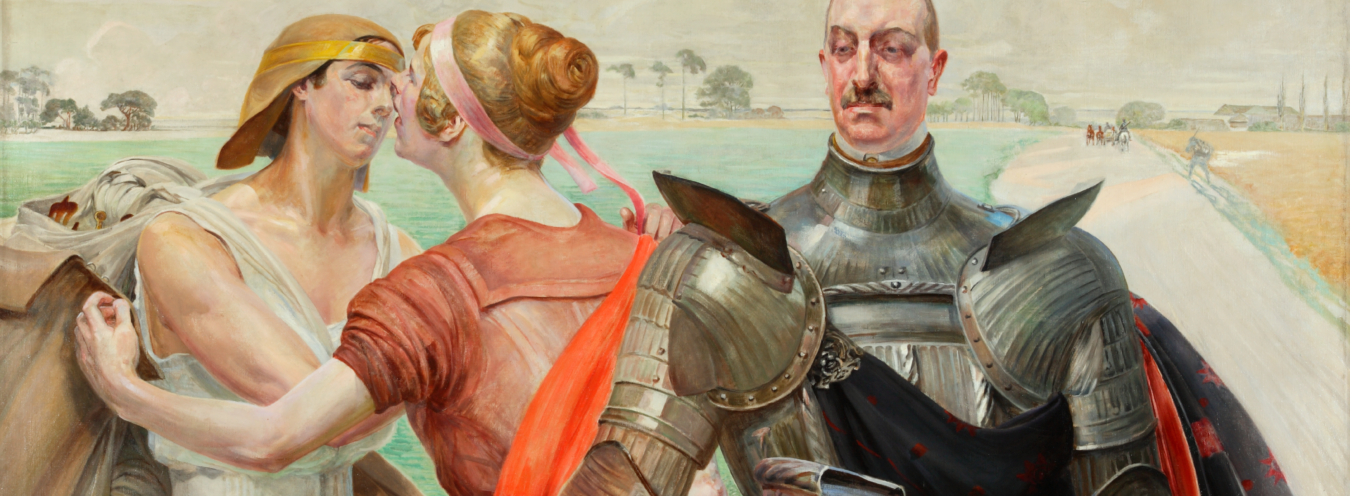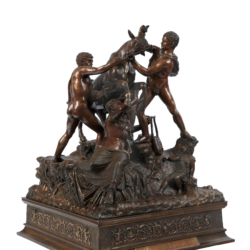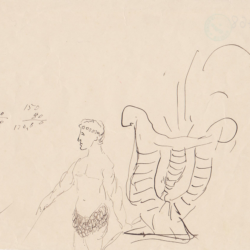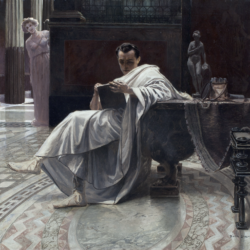
Polish Hercules vs. Gallic Hercules
As proved in the book by Jerzy Banach, the image of Polish Hercules, dating back to the 17th century, served mainly as an allegory of the ruler.[1] This is the function that Hercules Polonus also plays in Sienkiewicz’s writings; after all, Jeremi Wiśniowiecki is (Prince Yeremi) “the Slavic Hercules” (“Welcome, the invincible leader! The Slavic Hercules! Till death, we are going to stand at your side!”).[2] In his works, Sienkiewicz built the awareness regarding the fact that the identity of the mythological hero is complex, and the internal contradictions may become the subject of the narration about the paradoxes of heroism as a cultural ideal.[3] The author expressed this view, for instance, in an 1870 study devoted to Kasper Miaskowski, where he ironically noted that Hercules Polonus seems to become morally superior to the mythological (foreign) Hercules, who “was seduced by Omphale since he indulged himself with women and also due to his debauchery.”[4]
Andrzej Kmicic (Kmita) was also endowed with the qualities of Hercules, and, like the mythological hero, losing his mind due to the orders of Hera, he was often losing his mind in a destructive way: “I poured water on my head so as not to lose my mind,” he told the king.[5] Iwona Puchalska offers an interesting interpretation of this issue in a study of expiatory heroism in the works of Polish 19th-century writers, drawing attention to the touch of insanity in Kmicic’s literary biography.[6]
The name of Hercules is also given to 16-year-old Orso, arousing “female minds” in the scene in which he raises and defends Jenna.[7] The allusion to Hercules, a submissive lover of Omphale, appears also in the novel Na polu chwały (On the Field of Glory) in the image of Pągowski, an old despot, passionately attached to Miss Sienińska. Let us quote a meaningful dialogue between the protagonists:
“Virgil said that amor omnia vincit but forgot to add that also mutat,” said the priest, “This Delilah will not cut your hair because you are bald, Sir, but I am sure I am going to see you at her feet, spinning the distaff, as Hercules did at the feet of Omphale.”
“That’s not in my nature! I was always able to control not only my servants but also my family.”
“And so people say, but that is why you deserve it even more, Sir. Someone should take you well in hand.”
“And that’s a very nice hand!,” said Pągowski, in an unusually cheerful way.[8]
These allusions to the ambivalent heroism impersonated by mythical Hercules allow us to find in Sienkiewicz’s heterogeneous works the variants of heroism that escape the stereotype of the proud (but empty) name of “Polish Hercules.” Sienkiewicz’s Hercules goes beyond that.
Trying to answer the question whom he would be, it is perhaps worth mentioning another national version of Hercules, perhaps – paradoxically – closer to Sienkiewicz’s imagination, different but not contradictory in relation to the ideal impersonated by Hercules Polonus. In 1870, in a Parisian chronicle of the Biblioteka Warszawska magazine, Seweryna Duchińska discusses the history of French literature written by Émile Chasles[9] and draws attention to one part of this book – the one presenting the Gallic variant of the image of Hercules, described by Lucian of Samosata during his trip to Gaul. The symbolic L’Hercule Ogmius (Gallic Hercules) “is an old man with a bald head, with the remaining hair as white as swan’s down; his complexion is dark and swarthy, like an old soldier’s skin. One could say that this is Charon, emerging from the pit of hell.”[10] The hero is old and dejected. The attributes of his bygone youth (a lion skin, a club, a bow, and arrows) seem to be only of an ornamental nature since there are no young powerful muscles which could use them. The defining feature of Gallic Hercules is his literally physical attachment to his people. The thin chains flowing down from his tongue pierce the ears of the obedient Gauls. We have to add that the chains are very intricate, made of gold and amber, attention-grabbing on their own, enticing with their beauty.
“More than anything, the Gauls worshipped the power and the charm of words”[11] – this is the conclusion of the analysis of this symbolic image described by Duchińska.
Toutes proportions gardées, it can be claimed that in Polish literature, Sienkiewicz represents the literary movement that could be described as the narrativization of the herculean myth (as opposed to the allegoric functions presented by the variant of the Polish Hercules).[12] Sienkiewicz’s Hercules – let us use this name metaphorically and generally to seriously describe all Sienkiewicz’s heroes – is handsome, seductive, and mysteriously ambiguous. When contemplating beauty, rhetoric loses unambiguous nature.
Przypisy
- J. Banach, Hercules Polonus. Studium z ikonografii sztuki nowożytnej [Hercules Polonus: A study in iconography of modern art], Warsaw 1984, pp. 69–71.
- Dzieła [The Collected Works], vol. 7, p. 240.
- As Stefan Majchrowski reminds us in his book, in 1886 in a museum in Naples, Sienkiewicz “saw the Farnese Bull, Psyche, and Hercules, in a big collection of Pompean art” – see S. Majchrowski, Sienkiewicz, Kraków 1975, p. 133; trans. E. N.
- Dzieła [The Collected Works], vol. 45, p. 35.
- Dzieła [The Collected Works], vol. 14, p. 96.
- See I. Puchalska, “‘Oszalały Herkules’, czyli o bohaterstwie ekspiacyjnym w polskich narracjach dziewiętnastowiecznych (Adam Mickiewicz, Walery Łoziński, Henryk Sienkiewicz)” [‘Insane Hercules’ – on the expiatory heroism in Polish 19th-century narrations (Adam Mickiewicz, Walery Łoziński Henryk Sienkiewicz)], in Prace Herkulesa – człowiek wobec wyzwań, prób i przeciwności [Hercules’s labors: Man in the face of challenges, trials and adversities], edited by M. Cieśla-Korytowska, O. Płaszczewska, Kraków 2012, pp. 288–293.
- Dzieła [The Collected Works], vol. 3, p. 158.
- Dzieła [The Collected Works], vol. 27, p. 189.
- See É. Chasles, Histoire nationale de la littérature française [The National History of French Literature], Paris 1870, pp. 10–12. [the attached illustration comes from the frontispiece of this book: https://books.google.pl/books?id=z25LAAAAcAAJ&printsec=frontcover&hl=pl#v=onepage&q&f=false ].
- S. Duchińska, “Kronika paryska” [Parisian Chronicle], Biblioteka Warszawska 1870, vol. 2, p. 432.
- Ibidem.
- See. J. Banach, op. cit., p. 70 and the following.








